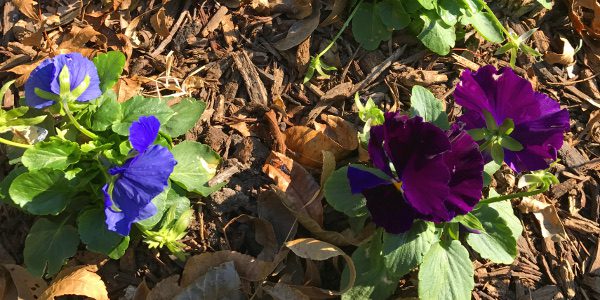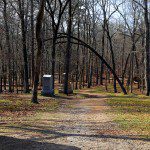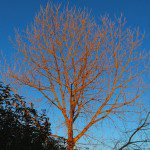As a Nature-centered Pagan, I enjoy celebrating Ostara, the Spring Equinox. It’s one of only two times of the year when the sun rises exactly in the east and sets exactly in the west. It’s a moment of transition – the dark half of the year ends and the light half begins. The promise of Spring that began at Imbolc is now well on its way to being fulfilled.
As a Deity-centered Pagan, I’ve never really known what to do with Ostara.
I have no connection to the Germanic Goddess Eostre. I once attended a lecture by a usually reliable history professor who claimed Isis was Ishtar was Astarte was Eostre was the Christian Easter. I found his argument less than convincing, and that was when my polytheism was far softer than it is today.
When I wrote a solitary ritual for Ostara I selected Danu as the Deity of the Occasion. Danu is a Mother Goddess and a Goddess of the Land, but I mainly chose Her because we have a long relationship. There are no stories or legends connecting Her to this day. I love the story of Persephone and Her association with Spring, particularly when it’s updated to restore Persephone’s agency instead of making Her Hades’ victim and Demeter’s possession. But I have no real connection to either the Goddess or Her story.
In a 2015 study of Alignment of the Western and Eastern Passage Tombs at Knowth Tomb 1, Frank Prendergast and Tom Ray demonstrated that Knowth is not aligned with the equinoxes. In their conclusion, they say:
Unlike the winter and summer solstice sunrise and sunset positions – which are discernible, observable and unique astronomical events with proven cultural, agricultural and ritual relevance – the equinoxes per se are more a product of historic and modern society’s knowledge, understanding and concern with the precise regulation of time and calendars. Arguably, such ideas had little relevance to the agrarian or ceremonial needs of Neolithic people.
Remember that it is the fire festivals (the cross quarters) of Imbolc, Beltane, Lughnasadh, and Samhain that were of greatest importance to our Celtic ancestors. Newgrange (and, I strongly believe, Stonehenge) were aligned to the Winter Solstice, but these monuments were built by pre-Celtic people.
So what’s an ancestral, devotional, ecstatic, oracular, magical, public polytheist to do?
To start with, I need to remember that my relationships with the natural world are as important as my relationships with the spiritual beings who share it with me. Animism is one of the key foundations of the religion I practice. Everything has a spirit – or perhaps, is a spirit. Everything is properly understood as a person to whom we can relate, not as an object for us to exploit as we see fit.
Beyond that, the Earth is literally our Great Mother and our Source of Life. We were not placed on the Earth, we grew out of the Earth. We are dependent on the Earth for our lives, and we cannot live separated from the Earth unless we take the Earth and her elements with us. ADF – an explicitly polytheist organization – begins its rituals by honoring the Earth Mother.
My polytheism puts the Gods first, but it is still a Pagan (from the Latin paganus, meaning “country dweller”) religion of the land, sky, and sea.
The Spring Equinox is an astronomical phenomenon, but its impact is strongly felt on the Earth. The revolution of the Earth around the sun combined with the tilt of its axis create a moment where the concentration of sunlight and the length of days are neutral, but they’ve both been growing since the Winter Solstice (in the Southern hemisphere they’re declining – as we celebrate the Spring Equinox they’re celebrating the Fall Equinox).
Pagan Ostara rituals tend to express this either in agricultural terms (“a season of planting”) or in psychological terms (“balance, growth, and renewal”). That’s certainly not wrong, but it’s never quite worked for me even though I’ve participated in plenty of such rituals and I’ve led some.
Since I’m not enamored with agriculture and I’m not fond of psychological Paganism, and since I have no relationships with a deity closely tied to the Spring Equinox, perhaps this should be my time to focus on Nature. What better time to honor the Earth Mother and to renew my commitment to Nature?
If Imbolc is the season for turning inward, then Ostara can be the season for turning outward to the wider world.
The days are longer and the temperatures are warmer. Winter is still in control in some Northern regions, but in many places outdoor activities are becoming not just possible, but pleasant. Here in Texas it’s the beginning of tornado season, when Nature reminds us that our place in the Grand Order of the Universe is not at the center of things.
Now is the time to honor the Earth Mother in ritual and in our daily lives.
Now is the time to salute the sun as it rises each morning in the East.
Now is the time to listen to the grackles as they gather in the morning and evening twilight.
Now is the time to spend more time outdoors.
Now is the time to move evening prayers from the indoor altar to the back yard.
Now is the time to return to the Wild.
If you’re happy with the way you observe the season of Ostara and the way you celebrate the holy day of Ostara, by all means keep doing them. I’ve participated in many of the usual ways and they’ve been good. But they no longer touch my soul and connect me to my source.
And so this is my reimagining of Ostara.


















